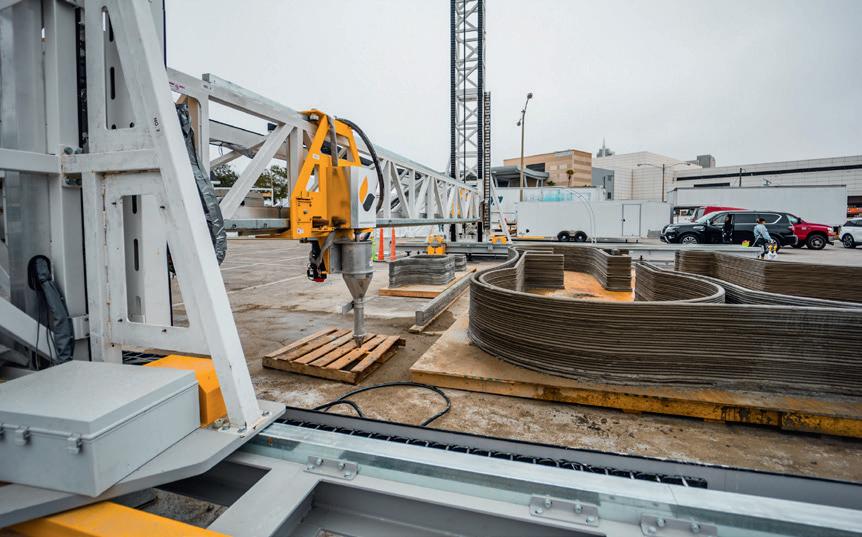3 minute read
AM MACHINE SHIPMENTS
Next Article
Chris Connery, Head of Global Analysis at CONTEXT provides insight into rising 3D printer revenues and slowed shipments.

Latest global market insights by CONTEXT show that aggregate 3D Printer unit shipments dropped by -4% during the third quarter of 2022, while systems revenues across the same time period rose by +14%. While great unit shipment disparities were seen across various printer priceclasses*, all segments saw system revenues rise from a year ago.

Inflationary pressures across the globe led to same-model price increases in all classes helping to prop up revenues. In a separate trend and also pushing up industry revenues, the Industrial metal segment also again benefitted from a shift in demand to more efficient and more productive machines such as for Metal Powder Bed Fusion models with more lasers and greater efficiency that enable higher outputs.

Industrial
Unit shipments in the period were characterized by (1) the continued rise in demand for Metal Powder Bed Fusion Systems, especially in China, (2) strong growth for Metal Directed Energy Deposition systems thanks in part to the emergence of new lowend player Meltio, and (3) rising Vat Photopolymerization shipments thanks to the bounce-back by UnionTech. UnionTech, in fact, drove most of the shipment growth in Q3 2022, bouncing back from their Covid lockdowns the prior quarter (when shipments were down -38% Y/Y) to sell +62% more printers than in Q3 2021. Over the period, China was not only the largest market (35% of the world’s Industrial 3D printers were shipped there) but also saw higher growth (+34%) than either North America or Western Europe.
Design
Shipments of Design printer systems were up significantly in Q3 2022, at +29%, increasing growth for the YTD to +22%. This was mostly due to sales of netnew products to the category including Formlabs Fuse 1+30W (already the fourthbestselling product in this price category), new DLP system from UnionTech, Stratasys’ Origin P3, Photocentric’s LC Magna and Desktop Metal’s Fiber system. New models accounted for 15% of shipments in the category with just two products, Fuse 1+30W and Origin P3, making up 9% of the category total.


Professional
In the Professional price class, shipments dropped −7% from Q3 2021: FDM/FFF printer shipments dropped −8% with SLA printer shipments down−21% from a year ago. FDM shipments were relatively flat over the YTD through Q3, with only −1% fewer products shipping than in the same period of 2021, but the same is not true of SLA shipments which were down −19% from 2021. UltiMaker (the newly combined MakerBot and Ultimaker), which produces both Professional and Personal printers, had a market share of 36% in this price class but in aggregate saw unit shipments drop −14% in the price class. Collectively, UltiMaker and Formlabs (which also saw reduced unit shipments) accounted for 51% of global Professional system revenues in Q3 2022. New to the category this quarter was Nexa3D which is now ramping up shipments of its XiP printers.




PERSONAL AND KIT & HOBBY

Growth in these low-end segments has significantly decelerated since the pandemic boom with both the Personal and the Kit & Hobby segments continuing to be dominated by market share leader Creality. Personal shipments fell -11% in the period. Kit & Hobby shipments were down -3% in the period, were down -10% from Q3 2020 (the pandemic boom) and were generally flat (up +2%) on a trailing twelve month’s basis. A significant bright spot is the emergence of Bambu Lab which, in Q3 2022, began shipping against its supersuccessful Kickstarter campaign that raised 7.1M USD against 5,513 pre-orders at ~1,200 USD apiece. Only two previous crowdsourced 3D printer initiatives have bettered this: Anker (8.9M USD) and Snapmaker (7.8M USD).
Outlook
Forecasts for 2023 have turned cautious as fears of regional recessions loom large and the worries that the loosening of China’s zero-Covid policy may reduce domestic demand and lead to further supply-chain disruption.


However, forecasts for key end-markets (including aerospace) and for key modalities – particularly Metal Powder Bed Fusion – remain strong. BLT and Eplus3D joined SLM Solutions and Velo3D to announce new large-format multi-laser metal systems to help meet this rising demand. Now that HP has fully launched its Metal Jet models and GE Additive is looking to commercialize its Series 3 products, Metal Binder Jetting machines may also help make 3D printing a more mainstream manufacturing process over the year to come.
* Price classes for fully assembled finished goods: Personal <2,500 USD; Professional 2,500–20,000 USD; Design 20,000–100,000 USD; Industrial 100,000+ USD. Kit & Hobby printers require assembly by purchaser.

Hear Chris dig into 3D printer shipments, trends, and more on the Additive Insight podcast: mytct.co/CONTEXT23













